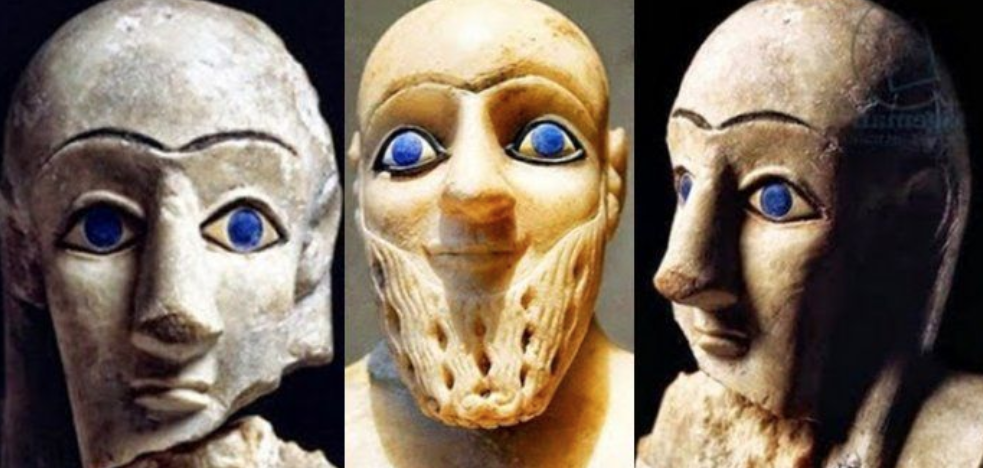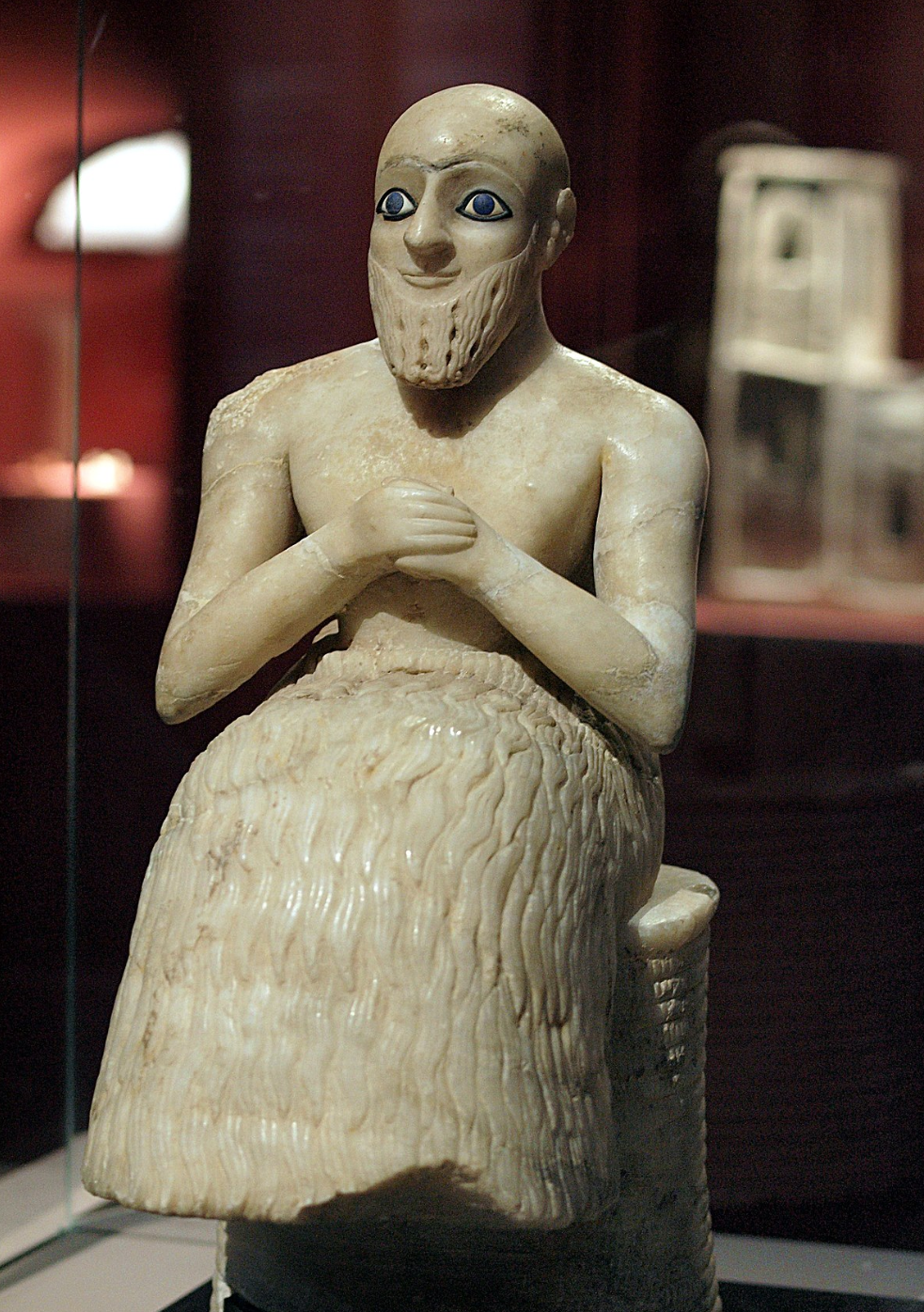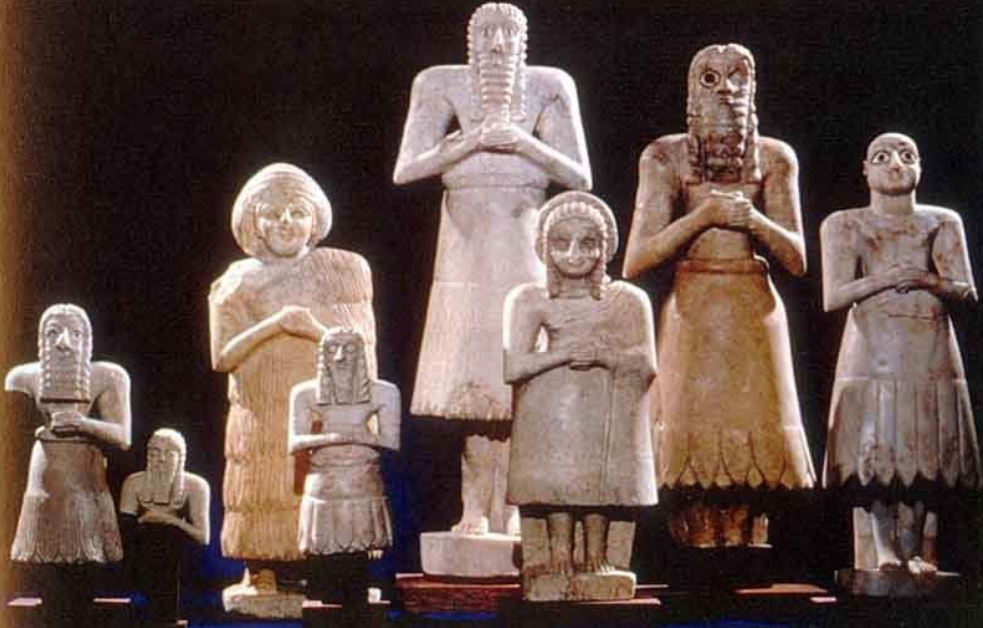Sumerians made several ancient statues of beings who had huge and blue eyes. These ancient statues were then placed in the high temple on top of the ziggurat. It seems clear that the eye motif on these figures was very significant to our ancestors.
Why are the eyes usually looking up to something? What was the purpose or symbolism behind those big blue eyes?

What Did Sumerians Look Like?
Forensic archaeologist Jane Shuter studied several Sumerian burial grounds that contained skeletons. According to her, Sumerians were short and solid. They had thin lips, straight thin noses, and eyes that sloped downward. Shuter and other archaeologists suggest that Sumerians were dark-skinned, dark-eyed, and dark-haired. Sumerians also referred to themselves as “the dark-haired people.”
More than 5,000 years ago, the Sumerian culture emerged on a floodplain along the Tigris and Euphrates rivers in Mesopotamian, a region today known as southern Iraq. The word Mesopotamia comes from Greek words meaning “land between the rivers.”

It was one of the most intriguing ancient civilizations that became famous for inventing cuneiform script.
The Sumerians built large cities and ziggurats with a terraced step pyramid and served as temples. Sumerians were skilled astronomers, they mastered medicine and created a sophisticated farming society. They were without a doubt one of the most advanced ancient civilizations.
Importance Of Religion In Sumerian Civilization
Ancient Sumer had a very complex pantheon of gods and goddesses, but four of these powerful figures played an important role because they were creators of everything. The Sumerian gods were depicted in human form. One of the most powerful and important gods was Enlil who arrived on Earth before humans were created.

When you look at each statue, you can see that there seem to be some rules for making the sculpture and at the same time a lot of variation. Image credit: Study Blue
Blue Eyes Were A Sign From The Gods
Scientists at the University of Copenhagen in Denmark have tracked down a genetic mutation, which took place 6-10,000 years ago, and is the cause of the eye color of all blue-eyed humans alive on the planet today. It is possible that some Sumerians did have blue eyes, but if that was the case it is unlikely it was many people. Blue eyes were by no means common among Sumerians.
Like many other ancient civilizations, the Sumerians considered blue eyes to be a sign of gods. Some eyes are outlined and those without anything but white for the eyes have most likely lost the color that was inserted when the sculpture was new.
The ancient Sumerian statues with big blue eyes have symbolic meaning. Each of these statues is different. The faces and clothing are not alike. This means the statues were not created to represent one important individual but many different persons.
According to Irene J. Winter at the Columbia University, New York, “the enlarged, staring eyes of Mesopotamian votive statues have often been remarked upon as a characteristic stylistic feature, only occasionally with the proposition that their function must have been to denote attentiveness toward the presumed object of their gaze. Yet, it is known that these statues were placed in shrines either seated within their own chapels or standing in direct visual contact with the resident deity.“

Without access to contemporary texts, it is difficult to say with certainty what the Sumerians thought when they created the big blue-eyes statues. However, blue eyes were associated with the gods, and since many of the beings are looking up, we can distinguish a heaven and earth connection.
Lady of the mask – Wari mummy with blue eyes.
Similar ancient statues with blue eyes have been discovered in other parts of the world, for example, in Egypt, India, and South America. The ancient Wari mummy, known as the Lady of the Mask discovered in Peru, became famous for her enigmatic blue eyes.
Blue was a very significant color in ancient times, and having blue eyes was considered divine. Most likely, our ancestors believed that people with blue eyes stood closer to the gods.



